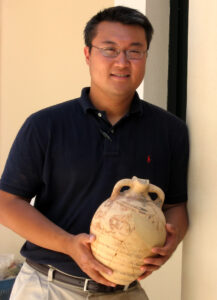We are excited to welcome Andrew Koh, of the MIT Center for Materials Research and the Harvard Semitic Museum, for a Center for Hellenic Studies Online Open House discussion entitled ‘A Land Called Crete: From Harriet Boyd Hawes to the Cretan Collections Project’. The event will be streamed live on Thursday, October 24 at 11 a.m. EDT, and will be recorded.
To prepare for the event you could read Odyssey 19.172–184, the context for which is provided in the following posts at Classical Inquiries:
- Mycenoan Crete—Archaeological Evidence for the Athenian Connection, by Andrew J. Koh
- A Cretan Odyssey, Part 1, by Gregory Nagy
and view the text from the second pylon of Ramesses III’s mortuary temple at Medinet Habu, which depicts the Ramesses III leading prisoners, with the gods Amun and Mut. You can see an image of the pylon inscription at this link (then scroll down to see the translation):
The OpenARCHEM project
The OpernARCHEM project is not a singular archaeological endeavor, but rather the first step in an exciting new collaborative interdisciplinary retelling of the entangled post-Bronze Age Mediterranean and the greater implications it holds for the emergence of what we now know as the classical world. The characterization of funerary artifacts from southern Phocis, eastern Crete, and the southern Levant will thus illuminate the extent to which Greece was wholly cut off from the greater Mediterranean, or clarify through which channels it interacted with particular regions as it entered the 1st millennium BCE.
You can watch the live stream on the day on the Center for Hellenic Studies YouTube channel. The recording will be added to the Kosmos Open House blog post afterwards.
Andrew Koh
 Andrew Koh received a B.S. in Biophysics and the Classics from the University of Illinois, an M.A. in Ancient Near Eastern Studies from Biblical Theological Seminary, and a Ph.D. in Art & Archaeology of the Mediterranean World from the University of Pennsylvania. He was a graduate fellow at the Penn Museum Corinth Computer Project and a Colburn Fellow at the American School of Classical Studies in Athens. He initially honed his interdisciplinary approach to the classical world by characterizing a perfumed oil workshop at the Minoan harbor town of Mochlos, dissertation research he completed as an exchange scholar at the Stanford University Department of Classics and the inaugural Archaeological Institute of America Pomerance Fellow. Koh is currently a senior research fellow at the MIT Center for Materials Research in Archaeology & Ethnology and a research associate at the Harvard Semitic Museum. He founded the ARCHEM Project in 2003 and now serves as the co-editor-in-chief of its interdisciplinary and collaborative archaeometric database (https://openarchem.org).
Andrew Koh received a B.S. in Biophysics and the Classics from the University of Illinois, an M.A. in Ancient Near Eastern Studies from Biblical Theological Seminary, and a Ph.D. in Art & Archaeology of the Mediterranean World from the University of Pennsylvania. He was a graduate fellow at the Penn Museum Corinth Computer Project and a Colburn Fellow at the American School of Classical Studies in Athens. He initially honed his interdisciplinary approach to the classical world by characterizing a perfumed oil workshop at the Minoan harbor town of Mochlos, dissertation research he completed as an exchange scholar at the Stanford University Department of Classics and the inaugural Archaeological Institute of America Pomerance Fellow. Koh is currently a senior research fellow at the MIT Center for Materials Research in Archaeology & Ethnology and a research associate at the Harvard Semitic Museum. He founded the ARCHEM Project in 2003 and now serves as the co-editor-in-chief of its interdisciplinary and collaborative archaeometric database (https://openarchem.org).
Koh utilizes both traditional and scientific methods to better understand cross-cultural interactions and complex societies through their organic commodities and branded goods. This approach integrates text, material culture, and material science, illuminating previously invisible data sets to address questions of culture and society. This blended approach offers exciting new ways forward for Classics and archaeology by introducing processes, social groups, and practices absent from other records. This interdisciplinary, longue durée approach underlies his monograph, Luxury Trade and Social Complexity in the Ancient Mediterranean World, which is under contract with Cambridge University Press.
Case studies have included the earliest known purple dye installation at the Minoan industrial site of Pefka, the Hellenistic trade in renowned Phoenician cedar oil during the Seleucid control of Tel Kedesh, and the earliest identified palatial wine cellar at the Aegean-influenced site of Tel Kabri. They demonstrate the ability to reconstruct ancient ecologies, economies, and behaviors tied to production (e.g. chaîne opératoire), trade (e.g. branding), and consumption (e.g. vessel reuse) with the added opportunity to critique ethnohistorical accounts (e.g. Pliny’s understanding of organic commodities and goods). Koh continues to conduct fieldwork in Greece, most recently at the cult center of Knossos in Crete and the Mycenaean citadel of Kastrouli in Phocis, which is equated with Homeric Anemoreia (Iliad 2.521). He is now completing the publication of volumes III and IV of the Cretan Collection at the Penn Museum (Betancourt 1983; Betancourt and Silverman 1991), which are based on the pioneering excavations by the first American Minoan archaeologists, including Harriet Boyd Hawes of Boston and her Smith College classmate, Blanche Wheeler Williams of Concord.
